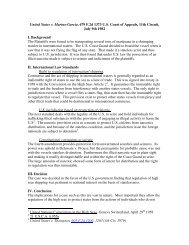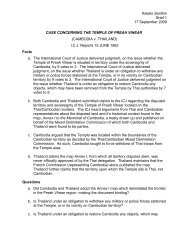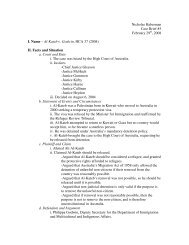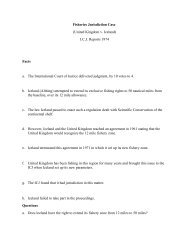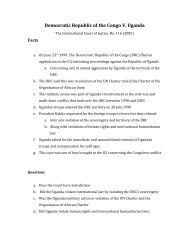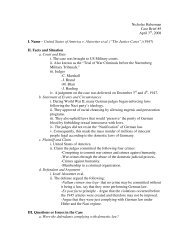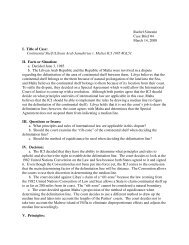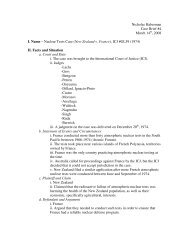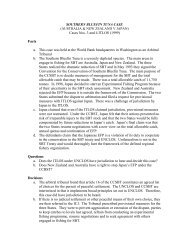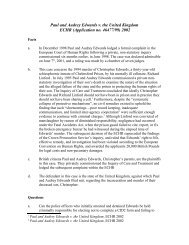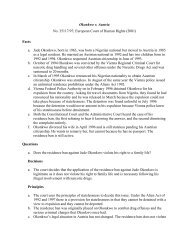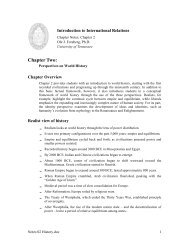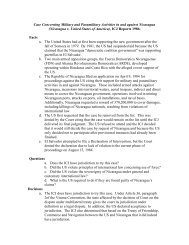Case Concerning Kasikili/Sedudu Island (Botswana v ... - Courses
Case Concerning Kasikili/Sedudu Island (Botswana v ... - Courses
Case Concerning Kasikili/Sedudu Island (Botswana v ... - Courses
Create successful ePaper yourself
Turn your PDF publications into a flip-book with our unique Google optimized e-Paper software.
<strong>Case</strong> <strong>Concerning</strong> <strong>Kasikili</strong>/<strong>Sedudu</strong> <strong>Island</strong> (<strong>Botswana</strong> v. Namibia)<br />
ICJ Reports, 1996<br />
Facts<br />
Questions<br />
a. On May 17 th 1996 <strong>Botswana</strong> and Namibia jointly filed a submission to the<br />
International Court of Justice requesting the Court’s settlement of a boundary<br />
dispute around <strong>Kasikili</strong>/<strong>Sedudu</strong> <strong>Island</strong>.<br />
b. Accompanying this request, <strong>Botswana</strong> and Namibia jointly submitted the text<br />
of a Special Agreement signed on February 15 th , 1996 referencing the Anglo-<br />
German Treaty of July 1890. This treaty established an agreement between the<br />
colonial powers of Great Britain and Germany and their respective spheres of<br />
influence over the two African nations. On these grounds and the principles of<br />
international law, both parties requested “the boundary between Namibia and<br />
<strong>Botswana</strong> around <strong>Kasikili</strong>/<strong>Sedudu</strong> <strong>Island</strong> and the legal status of the island.” 1<br />
The Court ruled by eleven votes to four, that the boundary follows the Chobe<br />
River around the island and that the island itself forms part of the territory of<br />
<strong>Botswana</strong>.<br />
c. The plaintiff, the nation of <strong>Botswana</strong>, argued that the island should be<br />
considered its territory unless it could be proven that the main channel passes<br />
through the south region of the island, and therefore falls within the<br />
sovereignty of Namibia. <strong>Botswana</strong> held that the north and west channels of<br />
the Chobe River constitute the “main channel”, and in accordance with the<br />
provisions of the Anglo-German Agreement of 1890, establish the boundary<br />
between the two nations. Accordingly, <strong>Kasikili</strong>/<strong>Sedudu</strong> <strong>Island</strong> falls<br />
exclusively within the sovereignty of <strong>Botswana</strong>.<br />
d. The defendant, Namibia, claimed that the main channel of the Chobe River<br />
indeed passes through the south of the island and that “Namibia and its<br />
predecessors had occupied, used, and exercised sovereign jurisdiction over<br />
<strong>Kasikili</strong> <strong>Island</strong> [with the knowledge and acquiescence of <strong>Botswana</strong>] since at<br />
least 1890.” 2 As such, <strong>Kasikili</strong>/<strong>Sedudu</strong> <strong>Island</strong> is a territory governed by the<br />
sovereignty of Namibia.<br />
a. Where exactly is the main channel of the Chobe located geographically in<br />
relation to <strong>Kasikili</strong>/<strong>Sedudu</strong> <strong>Island</strong><br />
b. How is the “main channel” defined and observed in relation to both nations,<br />
1<br />
Anglo-German Agreement of 1890<br />
2<br />
<strong>Case</strong> <strong>Concerning</strong> <strong>Kasikili</strong>/<strong>Sedudu</strong> <strong>Island</strong> (<strong>Botswana</strong> v. Namibia)<br />
ICJ Reports, 1996
Decision<br />
<strong>Botswana</strong> and Namibia<br />
b. What exactly is the dividing line between the colonial spheres of influences<br />
[established by the provisions of the Anglo-German Agreement of 1890], and<br />
why is this specific division important<br />
c. To what extend had Namibia “officially” occupied and exercised sovereignty<br />
over <strong>Kasikili</strong>/<strong>Sedudu</strong> <strong>Island</strong><br />
d. Is the historical occupation of the island important If physical characteristics<br />
of the land or water have shifted over time, should old maps be considered, as<br />
legitimate geographic references<br />
e. Is navigability a legitimate criteria to be used for identifying and delineating<br />
the path of the Chobe River’s “main” channel<br />
a. On December 13 th , 1999 the Court delivered its official judgment. The Court<br />
held, with eleven votes to four, that “the boundary between Namibia and<br />
<strong>Botswana</strong> around <strong>Kasikili</strong>/<strong>Sedudu</strong> <strong>Island</strong> followed the line of deepest<br />
soundings in the northern channel of the Chobe and that the island forms part<br />
of the territory of <strong>Botswana</strong>.” 3 The Court also ruled that while Namibia had<br />
historically occupied the island, the State functions in which it participated<br />
during seasonal occupation did not constitute ownership.<br />
b. The 1890 Treaty was used as important historical context for the definition of<br />
“thalweg”, or main channel, which maintained a legally defined association<br />
with navigability. 4 The Court upheld the definition of thalweg as “the line of<br />
deepest water along the length of a river channel…characterized by two and a<br />
smooth bed”. 5 The Court asserted that it could not draw conclusions from the<br />
cartographic material with the absence of any map officially reflecting the<br />
intentions of the parties to the 1890 Treaty, in light of the “uncertainty and<br />
inconsistency of maps.” 6 Based on this criteria, the Court also ruled to uphold<br />
the 1985 conclusion of the South African Department of Water Affairs, “the<br />
average depth of the thalweg of the North channel is greater than the southern<br />
channel…the main channel of the Chobe passes <strong>Kasikili</strong>/<strong>Sedudu</strong> <strong>Island</strong> to the<br />
north of it.” 7 The Court added unanimously that, "in the two channels around<br />
<strong>Kasikili</strong>/<strong>Sedudu</strong> <strong>Island</strong>, the nationals of and vessels flying the flags of, the<br />
3<br />
<strong>Case</strong> <strong>Concerning</strong> <strong>Kasikili</strong>/<strong>Sedudu</strong> <strong>Island</strong> (<strong>Botswana</strong> v. Namibia)<br />
ICJ Reports, 1996<br />
4<br />
Anglo-German Agreement of 1890<br />
5<br />
Alexander, “Science, History, and the <strong>Kasikili</strong> <strong>Island</strong> Dispute” South African Journal of<br />
Science<br />
6<br />
<strong>Case</strong> <strong>Concerning</strong> <strong>Kasikili</strong>/<strong>Sedudu</strong> <strong>Island</strong> (<strong>Botswana</strong> v. Namibia)<br />
ICJ Reports, 1996
Republic of <strong>Botswana</strong> and the Republic of Namibia shall enjoy equal national<br />
treatment.” 8<br />
Principles<br />
a. In order to appropriately determine the navigability of a water channel, inter<br />
alia, depth and width are the most important measures, which must be<br />
considered. These measures are necessary to compute volume capacity and the<br />
primary path of water flow. In this context, a water channel may be used in<br />
determining the boundary between two states.<br />
b. Occupation of a territory, á titre de souverain does not constitute legal<br />
ownership. In this case, although Namibia used the island [the fertile Caprivi<br />
strip] for seasonal agriculture purposes, “its functions of State authority were<br />
ultimately on behalf of Caprivi authorities.” 9<br />
b. As determined by Frontier Dispute (Burkina Faso v. Republic of Mali) ICJ<br />
Reports 1983, the evidentiary value of maps “constitutes information which<br />
varies from case to case; of themselves, and by virtue solely of their existence,<br />
they cannot constitute a territorial title endowed by international law with<br />
intrinsic legal force for the purpose of establishing territorial rights.” 10<br />
c.The rule of equitable utilization of watercourses and cartography as wellestablished<br />
principles of International Law. 11<br />
Conclusion<br />
a. The ability of the ICJ to resolve this dispute is significant primarily because<br />
it resolved a long-standing border dispute between the two African nations of<br />
<strong>Botswana</strong> and Namibia. This case is also important because bridges the gap<br />
between law and science and demonstrates the extent to which great difficulty<br />
exists in reconciling the two in a modern context. Of particular interest here is<br />
the fact that in addition to the ten lawyers, six scientists also participated in<br />
court proceedings to resolve this dispute. This was a necessary means of<br />
creating balance between historical precedents and the legal strain of this<br />
procedure on a scientist’s logical rationale. This case also revealed that in<br />
essence the dispute centered around both parties’ desire to procure political<br />
7<br />
Alexander, “Science, History, and the <strong>Kasikili</strong> <strong>Island</strong> Dispute” South African Journal of<br />
Science<br />
8<br />
<strong>Case</strong> <strong>Concerning</strong> <strong>Kasikili</strong>/<strong>Sedudu</strong> <strong>Island</strong> (<strong>Botswana</strong> v. Namibia)<br />
ICJ Reports, 1996<br />
9<br />
“Summary of the Decisions: <strong>Case</strong> <strong>Concerning</strong> <strong>Kasikili</strong>/<strong>Sedudu</strong> <strong>Island</strong>” World Court<br />
Digest<br />
10<br />
Frontier Dispute (Burkina Faso v. Republic of Mali) ICJ Reports 1983<br />
11<br />
<strong>Case</strong> <strong>Concerning</strong> <strong>Kasikili</strong>/<strong>Sedudu</strong> <strong>Island</strong> (<strong>Botswana</strong> v. Namibia)<br />
ICJ Reports, 1996
control and economic benefit from the rich natural resources and potential<br />
tourist lure of <strong>Kasikili</strong>/<strong>Sedudu</strong>’s naturally occurring productive abundance.
Bibliography<br />
<strong>Case</strong>s and Treaties<br />
<strong>Case</strong> <strong>Concerning</strong> <strong>Kasikili</strong>/<strong>Sedudu</strong> <strong>Island</strong> (<strong>Botswana</strong> v. Namibia) ICJ Reports, 1996<br />
Anglo-German Agreement of 1890<br />
Frontier Dispute (Burkina Faso v. Republic of Mali) ICJ Reports 1983<br />
Articles and Books<br />
“Summary of the Decisions: <strong>Case</strong> <strong>Concerning</strong> <strong>Kasikili</strong>/<strong>Sedudu</strong> <strong>Island</strong>” World Court<br />
Digest. The Max Planck Institute for Comparative Public Law and International<br />
Law. (November 2007)<br />
Alexander, W.J.R. “Science, History and the <strong>Kasikili</strong> <strong>Island</strong> Dispute”. South African<br />
Journal of Science, Aug99, Vol. 95 Issue 8. (accessed: 11/4/09)<br />
http://webworld.unesco.org<br />
Submitted<br />
Colleen Hill, November 5, 2009



